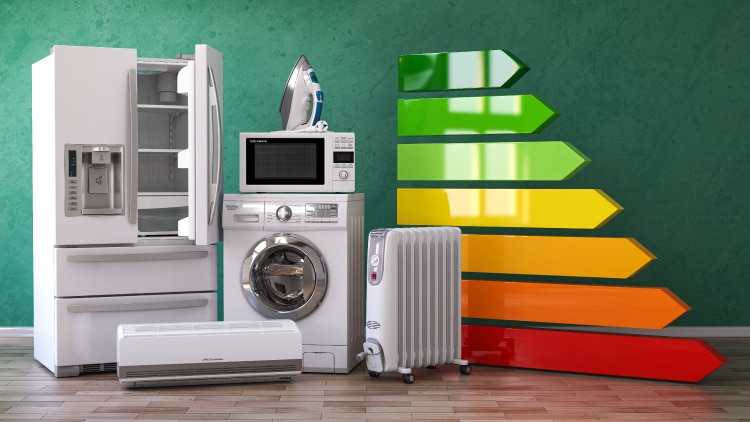

Energy Label Guide: Smart Tips for Buying the Most Energy-Efficient Appliances, Save Electricity and Money!
In today’s world, environmental protection and energy conservation awareness are on the rise. Choosing energy-efficient appliances not only helps reduce carbon emissions but also significantly lowers household electricity bills. However, with so many appliances on the market, how do you choose the ones that truly save electricity? Energy labels are a key reference tool. This article explains in detail the purpose of energy labels, how to read them, and provides guidance on selecting various types of appliances to help you choose the most energy-efficient ones, achieving both environmental protection and energy savings!
What is an Energy Label?
An Energy Label is a tag used to indicate the energy efficiency of household appliances. It is usually issued by government agencies or relevant institutions to help consumers identify how energy-efficient a product is, enabling more environmentally friendly and economical purchasing decisions.
Purpose of Energy Labels:
- Provide clear energy consumption data to easily compare different brands and models
- Help consumers choose more energy-efficient appliances and reduce daily electricity expenses
- Encourage manufacturers to develop more efficient products that meet environmental standards
- Reduce unnecessary energy consumption and mitigate climate change
In many regions, energy labels are mandatory. All appliances must display an energy label at the point of sale. Examples include Hong Kong's Mandatory Energy Efficiency Labelling Scheme (MEELS) and the EU Energy Label.
Energy Label Grading System
Energy labels typically use a grading system to indicate energy efficiency, allowing consumers to quickly identify which products are more energy-saving. For example, in Hong Kong and the EU, energy grades are commonly divided as follows:
| Energy Label Grading | |
Grade 1 (most efficient) |
highest energy efficiency, the most energy-saving among similar products |
Grade 2 |
high energy efficiency, slightly lower than Grade 1 |
Grade 3 |
moderate energy efficiency |
Grade 4 |
lower energy efficiency |
Grade 5 (least efficient) |
lowest energy efficiency, may consume over 30% more power than Grade 1 products |
Why Choose Grade 1 or 2 Appliances?
Choosing higher-graded products (Grade 1 or 2) can significantly reduce energy consumption. Although they might be slightly more expensive upfront, the savings in electricity bills over time often outweigh the price difference — making it a long-term investment.
How to Read Energy Label?
Energy labels contain more than just color codes or grade numbers. They include several key pieces of information to help consumers accurately compare energy usage. Common elements include:
- Energy Efficiency Grade: show the efficiency level (e.g. Grade 1 or 2)
- Annual Energy Consumption(kWh/year): estimated yearly electricity usage (in kilowatt-hours)
- Product Model and Brand: ensure correct matching between label and product
- Additional Info (varies by product):
- Air Conditioners → cooling capacity (BTU/h), energy efficiency ratio (EER)
- Refrigerators → volume, fridge/freezer compartments
- Washing Machines → water usage, spin performance
- Dehumidifiers → dehumidifying capacity (L/day)
Understanding these data allows consumers to choose the best-fit appliances based on their needs.
Energy Label Tips for Different Appliances
Each appliance type has different power requirements. Here's how to read energy labels by category:
1. Air Conditioner
- Choose Grade 1 inverter models to save 20-30% on electricity bills
- Check cooling capacity (BTU/h) based on room size
- Higher EER/SEER values represent better energy efficiency
2. Refrigerator
- Prioritize Grade 1 models
- Choose appropriate size to avoid excess energy usage
- Regularly clean the condenser for optimal performance
3. Washer
- Front-loading models are generally more efficient than top-loading ones
- Inverter technology reduces energy use during operation
- Consider washing and spinning performance grades
4. Dehumidifier
- Choose high-efficiency grades for long-term operation
- Ensure dehumidifying capacity (L/day) matches room size
Real-Life Case:
Energy Savings from High-Efficiency Appliances
Let’s compare the annual electricity costs between Grade 1 and Grade 5 Air Conditioner models:
Assume
- Label indicates yearly energy use based on 1,200 hours of operation
- Electricity cost: HK$1.4 per kWh
| Comparison of Electricity Costs between Grade 1 and Grade 5 AC | |
Grade 1 AC |
Grade 1 AC consumes 450kWh of electricity per year. The annual electricity bill is calculated as follows:
|
Grade 5 AC |
Grade 5 AC consumes 450kWh of electricity per year. The annual electricity bill is calculated as follows:
|
If the air conditioner is used for 1,200 hours a year, the annual electricity bill for a Grade 1 AC is $630, while the annual electricity bill for a Grade 5 AC is $1,050, with a difference of 40%. In the long run, these savings will gradually accumulate and bring substantial energy-saving benefits to consumers.
Choosing energy-efficient appliances not only helps the environment, it can also significantly reduce your electricity bills. Through energy labels, we can easily identify the energy consumption level of home appliances and choose the energy-saving products that best suit us.
Summary Tips for Choosing Energy-Efficient Appliances:
✅ Choose products with Grade 1 or 2 energy labels
✅ Compare annual energy consumption — the lower, the better
✅ Select appliances with suitable size and specifications for your needs
✅ Maintain good usage habits to further enhance energy savings
With these simple tips, every household can easily save energy and money, while also doing their part for the environment!

